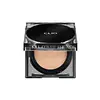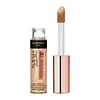What's inside
What's inside
 Key Ingredients
Key Ingredients

 Benefits
Benefits

 Concerns
Concerns

 Ingredients Side-by-side
Ingredients Side-by-side

Water
Skin ConditioningCyclopentasiloxane
EmollientCI 77891
Cosmetic ColorantEthylhexyl Methoxycinnamate
UV AbsorberButylene Glycol
HumectantEthylhexyl Salicylate
UV AbsorberLauryl PEG-9 Polydimethylsiloxyethyl Dimethicone
Skin ConditioningCetyl Ethylhexanoate
EmollientNiacinamide
SmoothingPolymethylsilsesquioxane
1,2-Hexanediol
Skin ConditioningCI 77492
Cosmetic ColorantMethyl Trimethicone
Skin ConditioningPEG-10 Dimethicone
Skin ConditioningSilica
AbrasiveIsododecane
EmollientAcrylates/Dimethicone Copolymer
Skin ConditioningMagnesium Sulfate
Alumina
AbrasiveTriethoxycaprylylsilane
Aluminum Hydroxide
EmollientOctyldodecanol
EmollientPEG-9 Polydimethylsiloxyethyl Dimethicone
EmulsifyingAdenosine
Skin ConditioningTrisodium Ethylenediamine Disuccinate
Dimethicone
EmollientPolypropylsilsesquioxane
Polyglyceryl-4 Isostearate
EmulsifyingIsopropyl Titanium Triisostearate
EmollientHydroxypropyltrimonium Hyaluronate
Tocopherol
AntioxidantParfum
MaskingBenzyl Benzoate
AntimicrobialLinalool
PerfumingLimonene
PerfumingMica
Cosmetic ColorantCI 77491
Cosmetic ColorantCI 77499
Cosmetic ColorantDisteardimonium Hectorite
StabilisingCetearyl Dimethicone/Vinyl Dimethicone Crosspolymer
EmollientCetearyl Dimethicone
EmollientStearic Acid
CleansingWater, Cyclopentasiloxane, CI 77891, Ethylhexyl Methoxycinnamate, Butylene Glycol, Ethylhexyl Salicylate, Lauryl PEG-9 Polydimethylsiloxyethyl Dimethicone, Cetyl Ethylhexanoate, Niacinamide, Polymethylsilsesquioxane, 1,2-Hexanediol, CI 77492, Methyl Trimethicone, PEG-10 Dimethicone, Silica, Isododecane, Acrylates/Dimethicone Copolymer, Magnesium Sulfate, Alumina, Triethoxycaprylylsilane, Aluminum Hydroxide, Octyldodecanol, PEG-9 Polydimethylsiloxyethyl Dimethicone, Adenosine, Trisodium Ethylenediamine Disuccinate, Dimethicone, Polypropylsilsesquioxane, Polyglyceryl-4 Isostearate, Isopropyl Titanium Triisostearate, Hydroxypropyltrimonium Hyaluronate, Tocopherol, Parfum, Benzyl Benzoate, Linalool, Limonene, Mica, CI 77491, CI 77499, Disteardimonium Hectorite, Cetearyl Dimethicone/Vinyl Dimethicone Crosspolymer, Cetearyl Dimethicone, Stearic Acid
Cyclopentasiloxane
EmollientWater
Skin ConditioningButylene Glycol
HumectantTalc
AbrasiveCetyl PEG/PPG-10/1 Dimethicone
EmulsifyingEthylhexyl Methoxycinnamate
UV AbsorberTrimethylsiloxysilicate
EmollientAcrylates Crosspolymer
AbsorbentCetearyl Ethylhexanoate
EmollientAmmonium Acrylates Copolymer
Dimethicone/Vinyl Dimethicone Crosspolymer
Skin ConditioningMagnesium Sulfate
Bis-PEG/PPG-14/14 Dimethicone
EmollientPolymethyl Methacrylate
Tribehenin
EmollientDisteardimonium Hectorite
StabilisingLaureth-7
EmulsifyingLecithin
EmollientParfum
MaskingPhenoxyethanol
PreservativeTrihydroxystearin
Skin ConditioningChlorphenesin
AntimicrobialTriethoxycaprylylsilane
Alcohol Denat.
AntimicrobialPropylene Carbonate
SolventDimethiconol
EmollientXanthan Gum
EmulsifyingGlycerin
HumectantDisodium Deceth-6 Sulfosuccinate
CleansingDisodium EDTA
Tocopheryl Acetate
AntioxidantLaureth-30
CleansingSodium PCA
HumectantUrea
BufferingSodium Dehydroacetate
PreservativeTrehalose
HumectantBenzyl Salicylate
PerfumingAlpha-Isomethyl Ionone
PerfumingHexylene Glycol
EmulsifyingLinalool
PerfumingCitronellol
PerfumingBHT
AntioxidantPolyquaternium-51
Skin ConditioningCaprylyl Glycol
EmollientTriacetin
AntimicrobialSodium Hyaluronate
HumectantPentaerythrityl Tetra-Di-T-Butyl Hydroxyhydrocinnamate
AntioxidantCI 77891
Cosmetic ColorantIron Oxides
Cyclopentasiloxane, Water, Butylene Glycol, Talc, Cetyl PEG/PPG-10/1 Dimethicone, Ethylhexyl Methoxycinnamate, Trimethylsiloxysilicate, Acrylates Crosspolymer, Cetearyl Ethylhexanoate, Ammonium Acrylates Copolymer, Dimethicone/Vinyl Dimethicone Crosspolymer, Magnesium Sulfate, Bis-PEG/PPG-14/14 Dimethicone, Polymethyl Methacrylate, Tribehenin, Disteardimonium Hectorite, Laureth-7, Lecithin, Parfum, Phenoxyethanol, Trihydroxystearin, Chlorphenesin, Triethoxycaprylylsilane, Alcohol Denat., Propylene Carbonate, Dimethiconol, Xanthan Gum, Glycerin, Disodium Deceth-6 Sulfosuccinate, Disodium EDTA, Tocopheryl Acetate, Laureth-30, Sodium PCA, Urea, Sodium Dehydroacetate, Trehalose, Benzyl Salicylate, Alpha-Isomethyl Ionone, Hexylene Glycol, Linalool, Citronellol, BHT, Polyquaternium-51, Caprylyl Glycol, Triacetin, Sodium Hyaluronate, Pentaerythrityl Tetra-Di-T-Butyl Hydroxyhydrocinnamate, CI 77891, Iron Oxides
 Reviews
Reviews

Ingredients Explained
These ingredients are found in both products.
Ingredients higher up in an ingredient list are typically present in a larger amount.
Butylene Glycol (or BG) is used within cosmetic products for a few different reasons:
Overall, Butylene Glycol is a safe and well-rounded ingredient that works well with other ingredients.
Though this ingredient works well with most skin types, some people with sensitive skin may experience a reaction such as allergic rashes, closed comedones, or itchiness.
Learn more about Butylene GlycolCi 77891 is a white pigment from Titanium dioxide. It is naturally found in minerals such as rutile and ilmenite.
It's main function is to add a white color to cosmetics. It can also be mixed with other colors to create different shades.
Ci 77891 is commonly found in sunscreens due to its ability to block UV rays.
Learn more about CI 77891Cyclopentasiloxane, or D5, is a silicone used to improve texture of products and trap moisture.
D5 is considered lightweight and volatile. Volatile means it evaporates quickly after application. Once evaporated, D5 leaves a thin barrier that helps keep skin hydrated.
It is also an emollient. Emollients help soften the skin and prevent water loss. Silicones create a silky texture in products. D5 helps other ingredients become more spreadable.
Studies show D5 is safe to use in skincare products. We recommend speaking with a skincare professional if you have concerns.
Learn more about CyclopentasiloxaneDisteardimonium Hectorite comes from the clay mineral named hectorite. It is used to add thickness to a product.
It can also help stabilize a product by helping to disperse other ingredients.
Hectorite is a rare, white clay mineral.
Learn more about Disteardimonium HectoriteEthylhexyl Methoxycinnamate is an organic compound that provides UVB protection. It often goes by the more common name of octinoxate. It is created from methoxycinnamic acid and 2-ethylhexanol.
Ethylhexyl Methoxycinnamate absorbs UVB rays with wavelengths between 280-320 nm. UV absorbers protect your skin by using chemical reactions to convert UV rays into heat and energy.
UVB (290-320 nm) rays emit more energy than UVA rays. They are capable of damaging DNA, causing sunburns and are thought to be linked to skin cancer.
The state of Hawaii has banned sunscreens containing octinoxate due to its potential impact on coral reefs. More research is needed to bridge gaps in this research. The European Union allows higher levels of octinoxate in sunscreens than the US and Australia.
Ethylhexyl Methoxycinnamate is oil soluble. It is not stable and may lose efficacy when exposed to sunlight.
Learn more about Ethylhexyl MethoxycinnamateLinalool is a fragrance and helps add scent to products. It's derived from common plants such as cinnamon, mint, citrus, and lavender.
Like Limonene, this ingredient oxidizes when exposed to air. Oxidized linalool can cause allergies and skin sensitivity.
This ingredient has a scent that is floral, spicy tropical, and citrus-like.
Learn more about LinaloolMagnesium Sulfate is a salt. More specifically, it is an epsom salt, or the bath salt used to help relieve muscle aches.
Despite having ‘sulfate’ in the name, it isn’t a surfactant or cleansing agent like sodium lauryl sulfate. Unlike those sulfates, magnesium sulfate doesn’t have the same cleansing or foaming properties (it's simply a type of salt).
In cosmetics, Magnesium Sulfate is used to thicken a product or help dilute other solids. It is a non-reactive and non-irritating ingredient.
One study shows magnesium deficiency may lead to inflammation of the skin. Applying magnesium topically may help reduce inflammation.
You can find this ingredient in sea water or mineral deposits.
Learn more about Magnesium SulfateParfum is a catch-all term for an ingredient or more that is used to give a scent to products.
Also called "fragrance", this ingredient can be a blend of hundreds of chemicals or plant oils. This means every product with "fragrance" or "parfum" in the ingredients list is a different mixture.
For instance, Habanolide is a proprietary trade name for a specific aroma chemical. When used as a fragrance ingredient in cosmetics, most aroma chemicals fall under the broad labeling category of “FRAGRANCE” or “PARFUM” according to EU and US regulations.
The term 'parfum' or 'fragrance' is not regulated in many countries. In many cases, it is up to the brand to define this term.
For instance, many brands choose to label themselves as "fragrance-free" because they are not using synthetic fragrances. However, their products may still contain ingredients such as essential oils that are considered a fragrance by INCI standards.
One example is Calendula flower extract. Calendula is an essential oil that still imparts a scent or 'fragrance'.
Depending on the blend, the ingredients in the mixture can cause allergies and sensitivities on the skin. Some ingredients that are known EU allergens include linalool and citronellol.
Parfum can also be used to mask or cover an unpleasant scent.
The bottom line is: not all fragrances/parfum/ingredients are created equally. If you are worried about fragrances, we recommend taking a closer look at an ingredient. And of course, we always recommend speaking with a professional.
Learn more about ParfumTriethoxycaprylylsilane is a silicone used to bind and stabilize ingredients.
As an emulsifier, it helps prevent ingredients from separating. This can help elongate the shelf life of products.
Triethoxycaprylylsilane is often used to coat mineral sunscreens ingredients to help give a better feel. It also helps reduce oxidative stress in sunscreens.
Learn more about TriethoxycaprylylsilaneWater. It's the most common cosmetic ingredient of all. You'll usually see it at the top of ingredient lists, meaning that it makes up the largest part of the product.
So why is it so popular? Water most often acts as a solvent - this means that it helps dissolve other ingredients into the formulation.
You'll also recognize water as that liquid we all need to stay alive. If you see this, drink a glass of water. Stay hydrated!
Learn more about Water